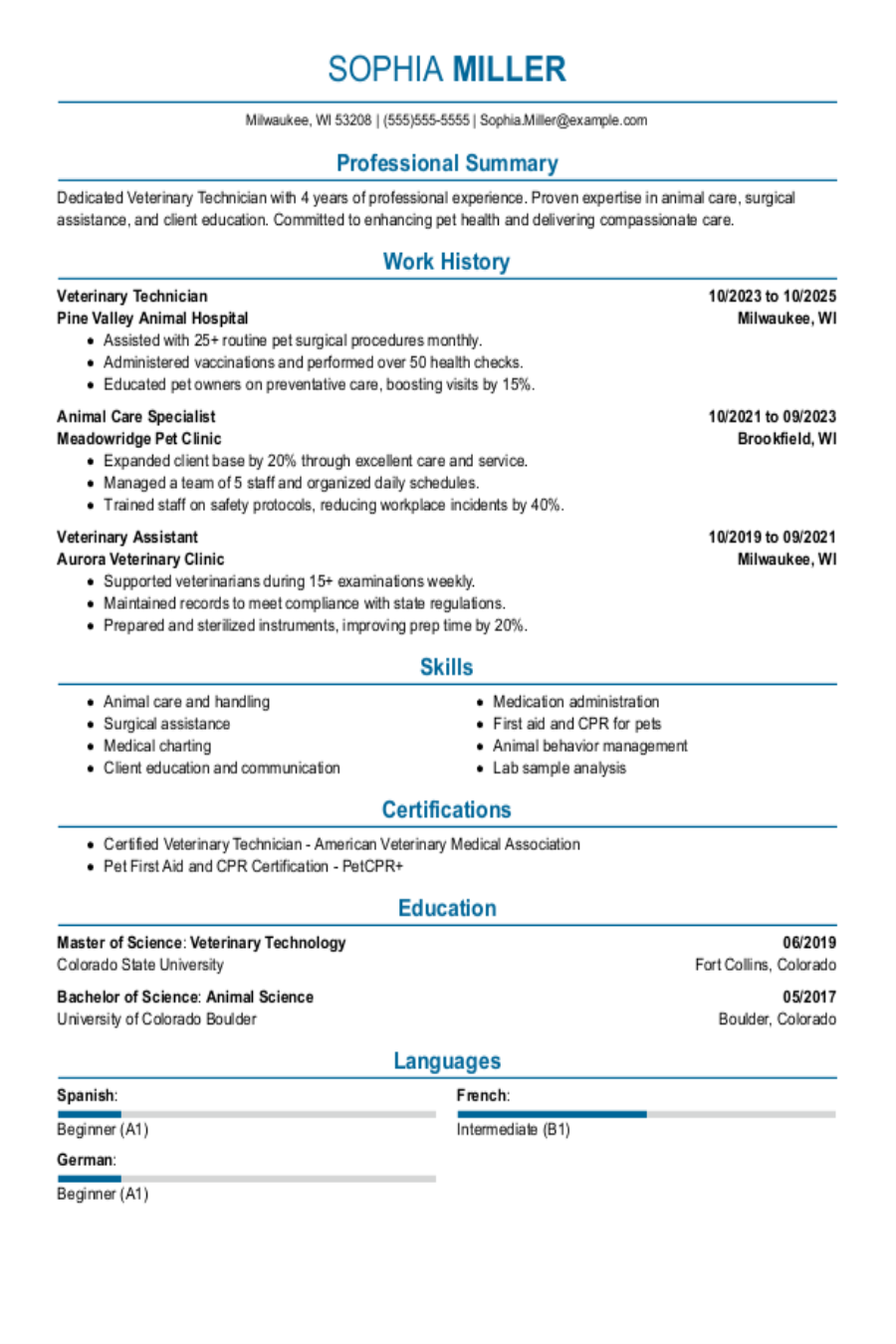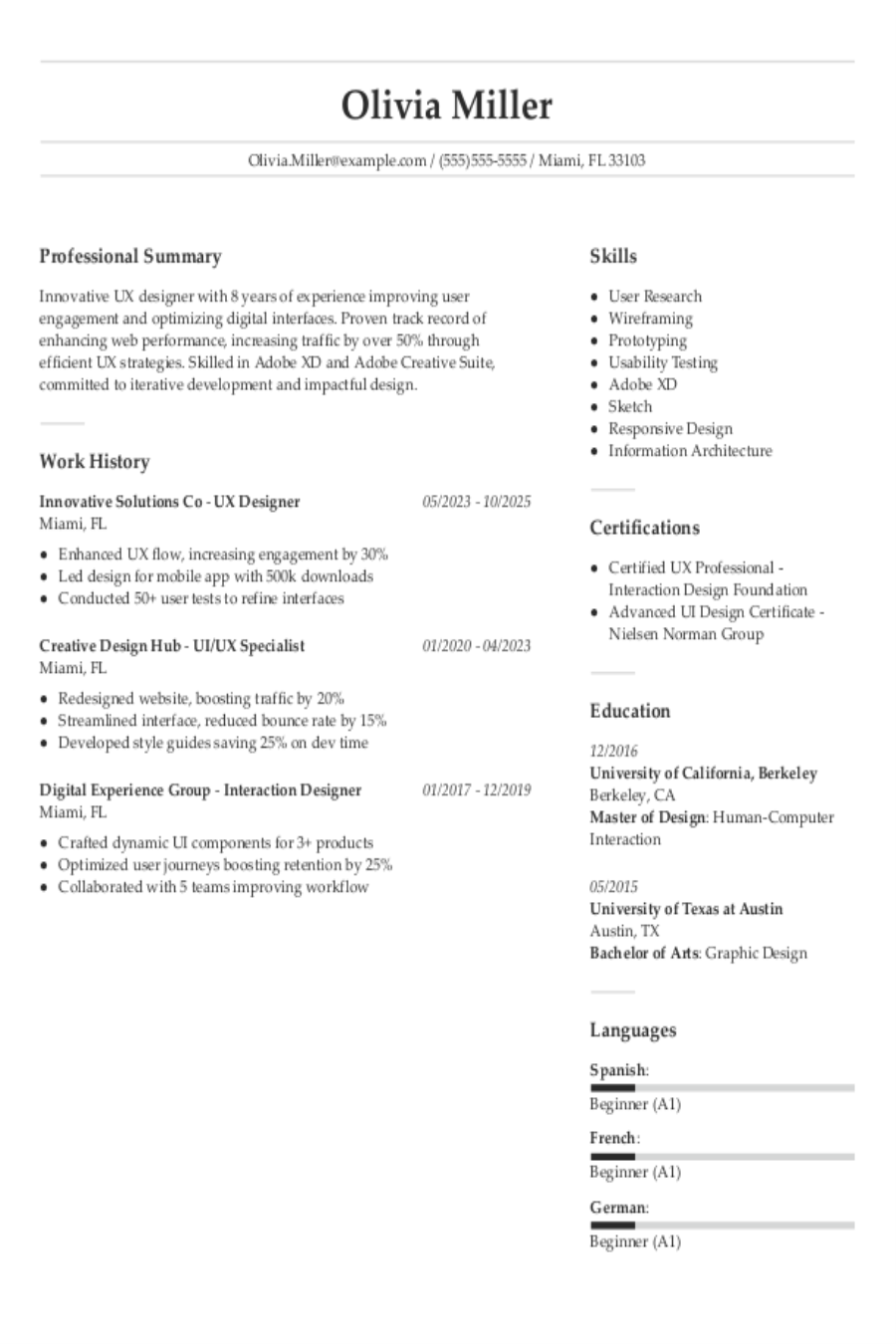Table of contents
Popular Family Nurse Practitioner Resume Examples
Entry-level family nurse practitioner resume
An entry-level resume for a family nurse practitioner should focus on clinical rotations, relevant coursework, certifications, and essential skills like patient assessment and care planning to highlight readiness for the role.
Emphasizes soft skills: This applicant's resume demonstrates strong soft skills like patient education and healthcare coordination, which effectively compensates for limited direct experience.
Focuses on goals: The job seeker's experience as a family nurse practitioner and advanced practice nurse demonstrates a commitment to improving patient care while focusing on professional development through continuous improvement in clinical skills and patient outcomes.
Mid-career family nurse practitioner resume
A mid-career family nurse practitioner resume should emphasize a combination of clinical experience, advanced skills, and continuous education to illustrate professional growth and commitment to patient care.
Begins with a powerful summary: This resume's professional summary highlights essential qualifications, showcasing extensive experience in patient care and telehealth services.
Employs active language: action verbs such as "managed," "reduced," and "implemented" clearly illustrate initiative and effective contributions, highlighting leadership in improving patient care.
Experienced family nurse practitioner resume
An experienced family nurse practitioner resume should highlight clinical skills, patient care achievements, and professional development to clearly demonstrate the applicant's impact in healthcare settings.
Optimized for ATS: The resume uses a polished and structured template that merges a professional header with an ATS-friendly resume design, optimizing visibility for both human reviewers and automated systems.
Follows traditional format: The chronological resume format clearly showcases the job seeker's extensive experience, presenting a logical sequence of roles and accomplishments that effectively illustrates their professional growth and career advancement in nursing.
No experience family nurse practitioner resume
A resume for an applicant with no experience as a family nurse practitioner should focus on relevant education, clinical rotations, and volunteer work to demonstrate the job seeker's potential and dedication to the field.
Uses a simple style: This resume's streamlined design highlights key qualifications, such as volunteer experience and educational achievements, ensuring a clear presentation of skills and accomplishments.
Emphasizes professional skills: Emphasizing essential nursing skills demonstrates the job seeker's capability to excel as a family nurse practitioner, leveraging volunteer experience to improve patient care and community health efforts.
More resume examples
Additional Guides
- Medical Surgery Nurse
- Neonatal Intensive Care Nurse
- New Grad Nurse
- Nurse Manager
- Nurse Midwife
- Nurse Practitioner
- Nurse Supervisor
- Occupational Health Nurse
- Oncology Nurse
- Operating Room Nurse
- Pediatric Nurse
- Pediatric Nurse Practitioner
- Perioperative Nurse
- Post Anesthesia Nurse
- Progressive Care Nurse
- Registered Nurse
- RN Unit Manager
- School Nurse
- Student
- Travel Nurse
- Utilization Review Manager
Family Nurse Practitioner Resume Template
Looking to create a standout application? Use this family nurse practitioner template as your foundation—just personalize it with your own details and experiences.
Li Miller
Silverlake, WA 98297
(555)555-5555
Li.Miller@example.com
Professional Summary
Compassionate Family Nurse Practitioner with 9+ years' experience in diverse healthcare settings. Proven track record of enhancing patient outcomes with innovative care strategies and team leadership, certified by leading nursing organizations.
Work History
Family Nurse Practitioner
Harmony Health Center - Silverlake, WA
January 2022 - October 2025
- Managed 180+ patient cases monthly
- Implemented telehealth increasing visits by 25%
- Developed patient care plans improving outcomes by 30%
Registered Nurse Specialist
Greenfield Hospital - Silverlake, WA
February 2018 - December 2021
- Led a team of 10 in acute care excellence
- Enhanced patient satisfaction score by 15%
- Trained 25+ junior nurses boosting team skillset
Care Coordinator
BrightPath Caregiving - Spokane, WA
March 2016 - January 2018
- Optimized scheduling reducing waits by 20%
- Coordinated care plans for 100+ patients weekly
- Reduced readmission rates by 10% through follow-ups
Skills
- Patient assessment
- Clinical protocols
- Medical diagnostics
- Electronic health records
- Telehealth
- Patient education
- Care management
- Team leadership
Certifications
- Advanced Cardiovascular Life Support - American Heart Association
- Certified Family Nurse Practitioner - American Nurses Credentialing Center
Education
Master of Science Nursing
University of Texas at Austin Austin, Texas
May 2015
Bachelor of Science Nursing
Texas A&M University College Station, Texas
May 2013
Languages
- Spanish - Beginner (A1)
- French - Intermediate (B1)
- Mandarin - Beginner (A1)
Must-Have Skills on a Family Nurse Practitioner Resume
A strong skills section is important for highlighting your qualifications on a resume.
Healthcare and medical professionals make a direct impact on individual and community well-being. The skills you highlight should reflect your ability to deliver dependable support and uphold high standards. Your resume is a chance to show how you contribute meaningfully to quality care and positive outcomes.
The following data outlines the most prevalent hard and soft skills necessary for a family nurse practitioner according to Resume Now’s internal resume data.
When you’re ready to improve your resume with compelling skills, consider using the AI Resume Skills Generator. It will recommend both hard and soft skills tailored to your job title, helping you create a comprehensive and customized skill set.
Writing Your Family Nurse Practitioner Resume
Having explored these effective resume examples, you're now prepared to dive into the process of crafting your own. We will guide you through how to write a resume step by step, examining each section in detail.
List your most relevant skills
An effective skills section on your family nurse practitioner resume should focus on including relevant technical skills, such as patient assessment and care planning, alongside essential soft skills like empathy and communication. Tailoring this section to reflect the keywords from the job listing can significantly improve your chances of standing out.
Using keywords from the job listing not only attracts human recruiters but also helps you pass applicant tracking systems (ATS). By aligning your skills with what employers seek, you demonstrate that you are a strong match for their needs.
Example of skills on a family nurse practitioner resume
- Proficient in assessing patient health through comprehensive evaluations
- Adept at developing tailored care plans for diverse families
- Strong communicator with a focus on patient education and support
- Compassionate caregiver dedicated to improving community health outcomes
A strong skills section is key for showing your readiness as a family nurse practitioner. It should include both the technical skills highlighted in the job description, such as patient assessment and care management, along with important soft skills like communication and empathy. This mix demonstrates to employers that you are ready to succeed in the role.
Highlight your work history
Your work experience section should highlight your achievements and the impact you've made in each role. Focus on showcasing how you’ve applied your clinical skills and knowledge in real-life situations, making sure to use relevant keywords that draw the attention of hiring managers.
For every job entry, include essential information such as your title, employer's name, and dates of employment. These details help establish your professional credibility and allow employers to quickly assess your background. Be sure to emphasize accomplishments that illustrate how you provided quality care or improved patient outcomes.
Example of a family nurse practitioner work experience entry
- Family Nurse Practitioner
HealthFirst Clinic - Dallas, TX
January 2021 - Present - Conduct comprehensive health assessments for diverse patient populations, developing individualized care plans that improve health outcomes
- Administer immunizations and manage chronic illnesses, demonstrating a 30% improvement in patient compliance with treatment protocols
- Educate patients and families on health management strategies, improving understanding of disease prevention and wellness practices
- Collaborate with interdisciplinary teams to optimize patient care and streamline clinical operations, resulting in a 15% reduction in appointment wait times
- Mentor and supervise nursing staff, fostering professional development and ensuring adherence to best practice standards
Quantifying achievements as a family nurse practitioner is vital to illustrate your impact on patient care. For example, indicating that you increased preventive screening rates by 40% over a year showcases your effectiveness in promoting health and improving patient outcomes.
Include your education
The education section of your family nurse practitioner resume should list your degrees and diplomas in reverse-chronological order, starting with your most recent qualification. Include relevant degrees such as a master's in nursing and omit your high school diploma if you possess a higher degree.
For those currently pursuing further education or with incomplete studies, it is essential to indicate your highest completed level along with an expected graduation date. Including bullet points for relevant coursework or academic accomplishments can provide additional context, especially for new graduates or students. This practice showcases the knowledge base you bring to the role.
Common certifications for a family nurse practitioner resume
- Family Nurse Practitioner Certification (FNP-BC) – American Nurses Credentialing Center (ANCC)
- Certified Family Nurse Practitioner (FNP-C) – American Academy of Nurse Practitioners Certification Board (AANPCB)
- Pediatric Nursing Certification (CPN) – Pediatric Nursing Certification Board (PNCB)
- Advanced Diabetes Management Certification (BC-ADM) – American Association of Diabetes Educators (AADE)
Sum up your resume with an introduction
A strong profile section on your resume is important for making an effective first impression. It serves as your personal marketing statement, summarizing your professional identity and drawing the attention of hiring managers to your qualifications right away.
If you have significant experience in the field, a professional summary is likely the best choice for your profile. This format allows you to showcase key accomplishments, relevant certifications, and specialized areas of expertise upfront. If you lack extensive work history, try a resume objective that reflects your goals and enthusiasm for development.
Professional summary example
Compassionate family nurse practitioner with over 5 years of experience in providing holistic patient care in diverse clinical settings. Demonstrated ability to improve patient outcomes through thorough assessments, personalized treatment plans, and effective health education. Proficient in chronic disease management, preventive care, and patient advocacy.
Resume objective example
Compassionate family nurse practitioner eager to use strong clinical assessment, patient education, and communication skills to improve patient care in a collaborative healthcare environment. Committed to providing high-quality support and fostering positive health outcomes for families in the community.
For family nurse practitioners, your resume profile is important for making a strong first impression. It's the ideal location to incorporate relevant keywords from the job description. Aligning your skills with the qualifications listed improves the likelihood of your resume passing through ATS filters and landing in front of hiring managers.
Add unique sections to set you apart
Improve your resume by adding optional sections that highlight your distinctive qualifications as a family nurse practitioner.
These sections allow you to present diverse elements of your professional persona—from healthcare-related hobbies to volunteer work that shows your commitment to community care. By showing how you dedicate personal time to developing relevant skills or participating in health outreach programs, you offer employers valuable insight into your passion and dedication.
Three sections perfect for a family nurse practitioner resume
- Languages: As a family nurse practitioner, effective communication is essential for patient care. Highlighting your language skills on your resume can improve patient interactions and improve health outcomes, demonstrating your ability to connect with diverse populations.
- Volunteer Work: Including volunteer work on a resume showcases your dedication to helping others while improving your skills. Highlighting this experience reflects your commitment to community service and adds depth to your professional profile.
- Accomplishments: As a family nurse practitioner, quantifiable accomplishments are essential for demonstrating the effectiveness of your care. Highlight these achievements by incorporating them into your work history or featuring them in a separate accomplishments section.
5 Resume Formatting Tips
- Choose a format that matches your career stage.
Choosing the right resume format is essential for showcasing your skills. If you are an experienced family nurse practitioner, a chronological format effectively highlights your work history. For those just starting out, a functional resume emphasizes relevant skills and education instead. To balance both experience and capabilities, consider using a combination format if applicable.
- Pick a smart resume template.
Using a professional resume template can significantly improve the readability of your document. With this approach, hiring managers can quickly identify key information. If you choose a custom layout, ensure it remains clean and uses ATS-friendly fonts to avoid formatting issues.
- Select an appropriate font.
Choose a clean and professional font like Helvetica, Georgia, or Verdana to improve readability and make your resume noticeable to both ATS and hiring managers.
- Use consistent formatting.
Ensure your resume is properly aligned with equal margins on all sides. This creates a polished and professional look that improves readability.
- Keep your resume to one or two pages.
When crafting your resume, keep in mind that resumes should be one page long for most applicants. Focus on concise content that emphasizes your qualifications and experience.
Tools for Your Job Search
Are you preparing to apply for that family nurse practitioner role you've been dreaming of? Before you hit send on your application, consider leveraging our ATS Resume Checker. This invaluable tool provides insights into how well your resume meets the criteria set by automated systems used by healthcare facilities during initial screenings.
Looking for a way to elevate your resume? Our AI Resume Builder offers tailored recommendations specifically designed for your nursing background, along with professional templates that effectively highlight your clinical expertise and unique qualifications.
Frequently Asked Questions
Last Updated: October 30, 2025
Absolutely. A cover letter is important because it adds depth to your resume and provides another opportunity for you to communicate directly with potential employers. It allows you to express your passion for the family nurse practitioner role and highlight how your unique experiences make you the ideal job seeker. So, take the time to write a cover letter that truly reflects your qualifications.
For a quick and efficient way to create your cover letter, try our AI Cover Letter Generator. It offers tailored solutions in just minutes, and you'll find various cover letter template options that perfectly match your resume, ensuring a consistent and professional presentation throughout your application materials.
A resume is typically concise, spanning one to two pages, and focuses on summarizing your skills and experiences relevant to a specific job. In contrast, a CV (curriculum vitae) can extend several pages and includes comprehensive details about your academic background, research contributions, publications, and professional experiences.
You’ll often need a CV for specialized roles in academia, healthcare, or research fields. If you’re preparing for such positions, our online CV Maker is an excellent resource. It allows you to create tailored CVs quickly and efficiently by choosing from various professionally designed CV templates suited for different industries and career levels.
A family nurse practitioner resume is typically one page long, which is often enough to highlight relevant experience and skills. However, if you have extensive qualifications or a diverse background, a two-page resume can effectively showcase your accomplishments.
To write a strong CV, focus on organizing your information under clear headings such as education, work experience, and skills. Choose professional templates that are both visually appealing and ATS-compatible. Tailor your content for each application by incorporating relevant keywords from the job description to ensure it resonates with potential employers.
Additionally, reviewing CV examples from industry professionals can provide valuable insights into effective presentation styles. Observing how successful job seekers showcase their qualifications can inspire you to improve your own CV and increase your chances of standing out in a competitive job market.
To ace your interview, practice common job interview questions and answers. This preparation boosts your confidence and equips you to handle any surprises that might come your way.
Was this information helpful? Let us know!
Hailey is a career advice writer dedicated to helping job seekers excel in their careers.
More resources

How to Write a One Page Resume: Guide & Examples for 2025
Was this information helpful? Let us know ...

What Is an ATS Resume? How to Write an ATS-Friendly Resume in 2025
The rise in applicant tracking systems (ATS) means resumes nee...

How to Use Resume Now’s Resume Builder for Free
Try Resume Now s AI-powered Resume Builder for free to access ...

Vet Tech Resume: Examples, Templates & Tips
Get inspired with our vet tech professional resume examples as...

UX Designer Resume: Examples, Templates and Tips
Check out our resume examples for help getting your UX designe...


